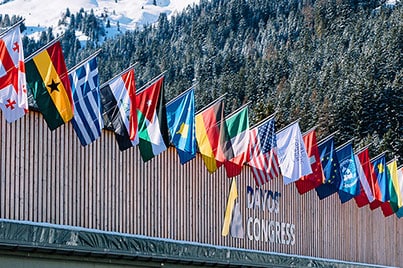
The 2020s will be a decade of upskilling. Employers should take notice
• The 2020s are becoming the decade of development for employees and employers in terms of skills and career progression.
• Employers believe that 44% of workers’ skills will be disrupted in the next five years and that six in 10 staff members will require training before 2027, according to the World Economic Forum’s Future of Jobs Report 2023.
• Here are five key factors to help nurture employees to ensure they are future-ready in an age of rapid change.
10 Jan 2024


How to rethink the 'capital' in stakeholder capitalism
• Seismic economic, geopolitical and technological shifts in the global landscape are challenging the modus operandi of companies and CEOs.
• Leaders need to build their businesses around five types of capital to survive the volatile times to thrive in the longer term.
• The five types of capital align with the World Economic Forum’s stakeholder capitalism metrics, as outlined in its Measuring Stakeholder Capitalism white paper.
15 Jan 2024


Insider’s Guide To Davos
Since 1971, world leaders and titans of industry have descended on the small Swiss town of Davos every January to attend the World Economic Forum's Annual Meeting. But what exactly is “Davos”, as the event is frequently referred to in the media, who gets to go and what happens there? Here’s a beginner’s guide to the event being held 15-19th January.
11 Jan 2024


A look at the cinema industry as we enter 2020
After an admittedly nervous start, 2019 became another record year for global theatrical receipts, following on from record 2018 results. As the National Association of Theatre Owners (NATO) highlighted at CinemaCon this year, global box office sales of US$41.7bn for 2018 had increased 32% since 2010. To see such robust box office growth at international level, reinforces our optimism for the industry’s future; and this optimism is predicated upon the belief that industry players will continue to work collaboratively to enhance cinematic content, ensure targeted distribution and constantly innovate our experiences.
14 Jan 2020


How to achieve growth in the MENAP region
The story behind tapping the potential for the Middle East, North Africa, Afghanistan, and Pakistan (MENAP) region is rather similar to the popular children’s tale of a small plucky train, a stalled locomotive, and challenging terrain.
- A thriving private sector is essential to drive sustainable economic growth.
- Economic integration will make MENAP a more competitive region.
- Selective deregulation, free movement of resources and common standards will encourage economic integration.
16 Jan 2020


Six ways to cut through the Middle Easts geopolitical fog
As the world is transformed by seismic developments around technology, climate and the need for more inclusive economic and social systems, there is a real risk that many in the Middle East will miss out on the opportunities these momentous shifts present, given the current geopolitical uncertainty about the region.
31 Jan 2020


Retailers can encourage sustainable behaviour
- Retailers have a unique opportunity to encourage behavioural change.
- The key is to make it easier for consumers to make better choices.
- The prize can be healthier and more sustainable lifestyles for all.
- The key is to make it easier for consumers to make better choices.
- The prize can be healthier and more sustainable lifestyles for all.
08 Jan 2020


Catalysing growth in the Middle East
The region’s economies are at a crossroads.
Spanning Pakistan to Morocco, MENAP represents 8.5% of the world’s population. But we only generate 3.4% of global GDP, with just two of our companies making it into the Fortune 500. Estimated growth in 2019 amounted to just 1%, and the outlook across the region remains one of low to no growth.
11 Feb 2020


The Rise of Green and Responsible Investment
The impact of climate change on our societies has been growing at an alarming rate, resulting in a need to transition nations towards green and low-carbon economies. To address the current environmental challenges, researchers estimate a funding gap of around US$200 billion to US$1,000 billion annually . Much of the investment is needed to cover infrastructure needs. In 2015, it was estimated that an annual gap of US$1 trillion is needed to build regular infrastructure projects. Back then, only 7-13% of infrastructure projects were low-carbon and climate-change resilient (LCR) .
01 Feb 2020


How we create a sustainable future for all
The coronavirus pandemic has been a dark and difficult time for us all: our communities, our people and our companies have been hurt economically and socially as the velocity of physical movement, interaction and commerce has slowed.
In spite of this, I believe we are living through a moment of great opportunity, a time when we can rebuild our world in a way that will have a lasting and positive impact.
In spite of this, I believe we are living through a moment of great opportunity, a time when we can rebuild our world in a way that will have a lasting and positive impact.
09 Sep 2020


Raising a tiger / Lessons for human capital
Raising and developing our own talent is vital in an age of 'talentism', writes Mustafa El Rafey, senior vice president of human capital at Majid Al Futthaim Retail.Are you kidding? There’s teeth on the other end!”
01 Mar 2020


Changing mindsets on climate action in MENA
It’s time to up our game when it comes to sustainable living in the Middle East.
04 Sep 2020


Why I believe in the potential of open data
Today’s world has considerably more data and more means to interrogate that data than ever before. While the data advancements made in recent years are well reported, the coronavirus pandemic has revealed that we are not yet realising the full potential of the data that exists.
10 Dec 2020


One letter and a world apart: Reflections on recovery analytics
I’ve talked a great deal this last week about the Majid Al Futtaim advanced analytics that detail the recovery of the UAE’s retail economy. But even as the top-line findings continue to make headlines, there is still much to be gleaned from the finer details.
22 Dec 2020


How the best climate practices can make great business sense
The power of collective action is evident in the global response to coronavirus. However, while countries harnessed technology across sectors – health, education and research – the pandemic exposed the fragility of the global economy.
08 Dec 2020


How collaboration will help establish a circular economy in the MENA region
Ever since the industrial revolution, economic development in large parts of the world has been heading in one direction, towards a “throwaway society”. Economic growth has revolved around a “take, make, use and waste” model: we take resources out of the ground, make products and discard them as waste when they are no longer needed.
27 Dec 2020


Tackling Embodied Carbon Reduction: Why Cooperation is the Viable Solution
There is no doubt that climate change is one of the greatest challenges of our time. Yet despite the vast amount of information experts are producing on this subject, embodied carbon reduction is a vital topic that commands less column inches and is achieving minimal progress outside a few advanced international companies. If we fail to acknowledge the risks associated with embodied carbon, the Middle East, North Africa and Asia could find itself reactively addressing rapidly changing industry guidelines. While the need to address this issue is low at the moment in comparison to operational carbon, if it’s not addressed, the embodied carbon challenge becomes greater and greater. The issue is also magnified by the figures being produced by numerous leading international bodies, many of which paint a remarkably sombre picture if action is delayed.
21 Dec 2020


Here's why the business of sustainability has come of age
- There is a unique opportunity for businesses to lead the way when it comes to sustainable investments.
- But it needs the support of governments and regulators, and it will require hard dollars and soft power.
- By seizing the opportunities and working together, the private sector can not only create a more sustainable future, but can unlock significant long-term value, for business and for society.
04 Nov 2020


The accelerated transformation of corporate learning
Corporate learning and development (L&D) has undergone a digital revolution in recent months − and a much needed one. As companies have pivoted, creating new virtual programmes for thousands of colleagues, it has become clear these shifts will have profound, ongoing implications for the way we think about learning, both, as learners and as learning professionals. Getting this right will propel organisations into the world of ‘Learning for the Digital Age’.
10 Nov 2020


Is it bricks or clicks for retail recovery
As a retail industry professional responsible for a portfolio of 27 physical and experiential retail spaces across the Middle East, I have been watching closely as the global pandemic created a new digital paradigm. For many in our industry, these represent truly unprecedented times.
16 Jul 2020

X